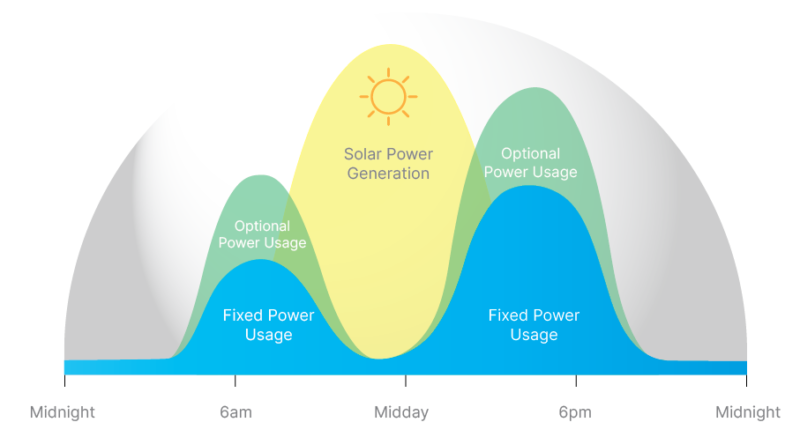What is Load Shifting?
When talking about electricity consumption we often talk about how much we use or how we can be more efficient with the energy that we do consume. Load shifting (or peak shaving) however, deals with the questions of when energy is used, rather than how much.
Without load shifting, non-fixed or optional power use (for instance your dishwasher, pool pump, heating and cooling) generally occurs during peak periods in the morning and evening as shown in the diagram below.

In Australia, we have high rooftop solar penetration which means that during the day when the sun is shining, there are large amounts of renewable energy on the grid. Households and businesses can take advantage of these surplus renewables on the grid by shifting their load to these times, for example by setting their dishwasher to run during the day or timing their air conditioner to cool the house before they arrive home in the evening.

So what’s in it for the consumer?
Well, if you have rooftop solar at home, load shifting from the evening to the middle of the day can take advantage of your own solar generation – especially important now that feed-in tariffs aren’t what they once were. Shifting consumption to use less fossil fuel-generated energy in the evenings is also a win for the environment and helps balance the grid.
Even if you don’t have rooftop solar on your home, you may be able to access discounted rates or subsidies. In some cases, this could mean shifting your optional energy use into the middle of the day to access a cheaper rate or a rebate (known as “Solar Sponge” incentives) and in others, it could be by shifting your optional energy use away from the evening peak (known as “Peak Shaving” incentives). The more of your optional power usage you can shift the greater the rewards you can access from these programs.
Next, we’ll show you how you can become a load shifter and benefit from these incentives.
Load Shifting Tips
Obviously, there are some things you can’t schedule, like your fridge running or when you cook dinner. However, we’ve put together some simple tips to help you become a load-shifter.
1. Cooling or heating your house before you get home.
Use your device’s inbuilt timer to heat or cool your house before you get home. Heating and cooling make up to 40% of your household energy bills so shifting this usage can pay huge dividends over time.
2. Use timers or delay functions to shift optional, non-time-sensitive use to the middle of the day.
For example:
-
- Put a timer on your dishwasher and let it run during the middle of the day.
- Load up your washing machine and use a timer to run it during the day. If you’re using a dryer, use it during the weekend when you’re home during the day.
- If you own a pool, time your pool pump to run during times of peak solar.
- Charge your Electric Vehicle in the middle of the day, not during the evening.
3. Practice conservation during peak times
During peak times, it’s important to keep on top of your energy use. Make sure to turn off your lights, TVs and electronics when they’re not being used. Consider delaying your use of appliances, or if you have to use them make sure to use their eco-modes. For more information on the main sources of energy use in your household check out our article.

Conclusion
Load-shifting isn’t complex, and the small and easy to execute changes above can help you load-shift and ultimately create a more stable and renewable friendly energy grid for all of us. Real-time feedback is important to this process and energy monitors like Powerpal are invaluable in taking control of your energy usage.
